Back to school this year is different than any other year. This graphic has been making its way around social media, and provides some useful and encouraging ways to help children process their fears, anxieties, and hopes, and pray about them.

Back to school this year is different than any other year. This graphic has been making its way around social media, and provides some useful and encouraging ways to help children process their fears, anxieties, and hopes, and pray about them.

 The Youth and Children team have worked with the Schools team to create a leavers’ service that can be done virtually, or with some children at school and some at home. It requires no physical contact and no sharing of resources. It’s designed to have different building blocks, appropriate for years 2, 4, 6, and 8, so you can use it for transitions to junior, middle, secondary, or high school.
The Youth and Children team have worked with the Schools team to create a leavers’ service that can be done virtually, or with some children at school and some at home. It requires no physical contact and no sharing of resources. It’s designed to have different building blocks, appropriate for years 2, 4, 6, and 8, so you can use it for transitions to junior, middle, secondary, or high school.
You can download it here:
Here is a selection of photographs of roads or journeys, which can be used by schools during the online/partly-in-person leavers’ service during the “may the road rise to meet you” blessing, as suggested. They are all taken by Margaret, our Children’s Mission Enabler, and she gives full permission for their use in worship in schools and churches.






Today I visited The Knitted Bible in its latest host site of Hampstead Parish Church. While St. Albans Diocese has an impressive fondness for knitted Bible stories – our cathedral’s large knitted Nativity, the smaller knitted Nativity and Noah’s Ark available to borrow from our Resource Centre, and many other knitted Bible sets around the Diocese – this goes beyond even our impressive yarn-based Biblical efforts.
It consists of around 35 scenes, from Creation to Jesus’s breakfast on the beach after his resurrection, each painstakingly re-created in yarn and stuffing, often with ingenious sets made of everything from kitchen roll to upside-down flower pots. (Please note: it does include the sacrifice of Isaac, without a huge amount of material provided about that story apart from “God wanted to see if Abraham would obey,” which is a simplistic reading that can be damaging to children’s ideas of God, and scary for them. Rabbis I have spoken with tend to interpret that story more as Abraham misunderstanding God, thinking God wants human sacrifice like the pagan gods of the time, and God stopping Abraham, clarifying he does not require human sacrifice. You may want to remove this scene from your display or provide additional material to give it context.)
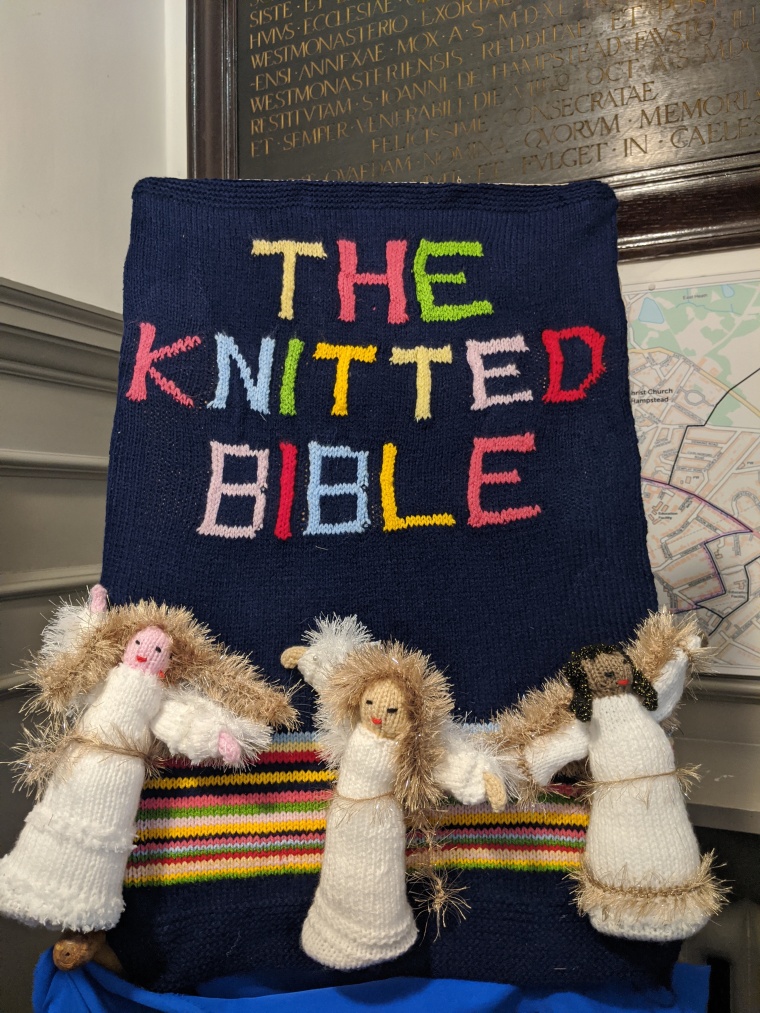

The Knitted Bible was created in 2008 by over 40 people at St. George’s URC in Hartlepool. It is available for churches to borrow without charge – however, it’s booked up very far in advance. If you’re interested in borrowing it for your church in late 2021 or even 2022, contact information can be found here.
While that may seem far away, it’s definitely worth considering if this is something you might be interested in doing. I spoke with the stewards on site, the church’s administrator, and with the Rev. Jeremy Fletcher, Vicar of Hampstead. The stewards and the administrator told me they’ve received a marked increase in foot traffic in the church over the ten days the Knitted Bible has been in situ. The stewards said it’s been a wonderful point of engagement with the local community – the church school has brought several classes to visit, it’s been out during worship for people to look at and explore, and people of all ages have engaged with it.
Rev. Jeremy said, “lots of people have told me they expected to be charmed by it. And that they were surprised to find that they were both charmed and moved by it.” He suspects a lot of what’s so moving about it is the detail. Every person and animal is an individual, and has their own story to tell, and little details in the setup – from a steward in the act of pouring wine at the Wedding at Cana to the little foil tip on a Roman soldier’s spear – draw the viewer in and inspire wondering and imagination.

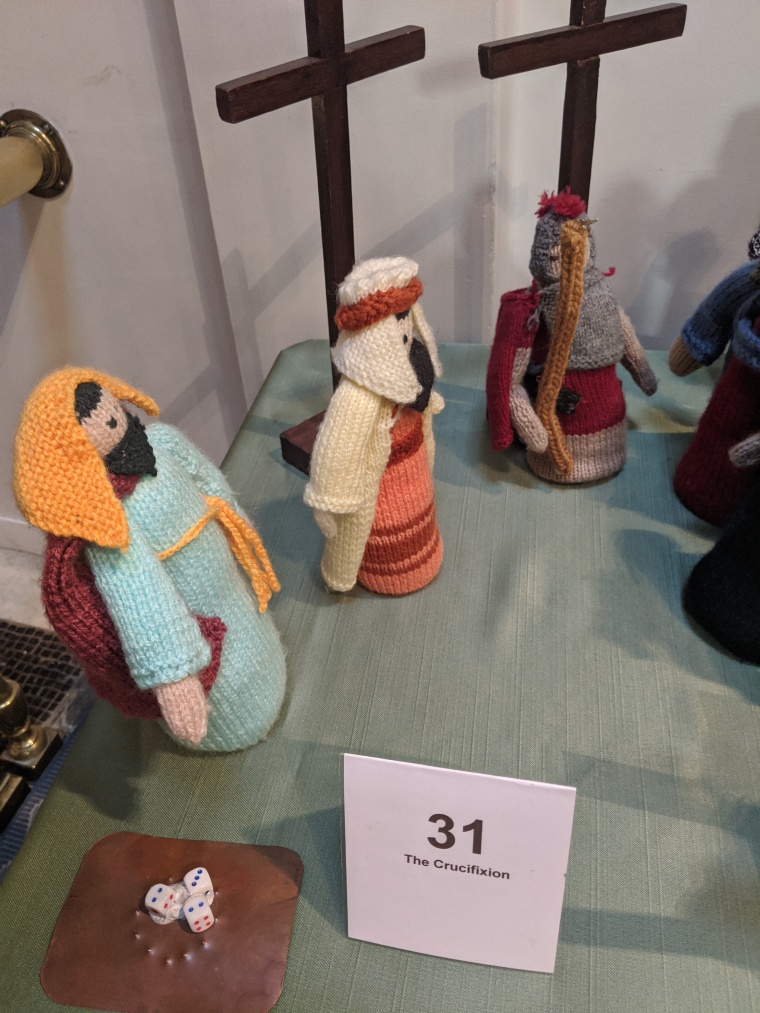
Visiting the Knitted Bible could serve as a springboard for follow-up activities as well, in schools, or church children’s/mixed age groups, such as:
Here are some more photos. Maybe you’ll be inspired and create a knitted Bible – or at least a few scenes – of your own!
HEBREW SCRIPTURES:







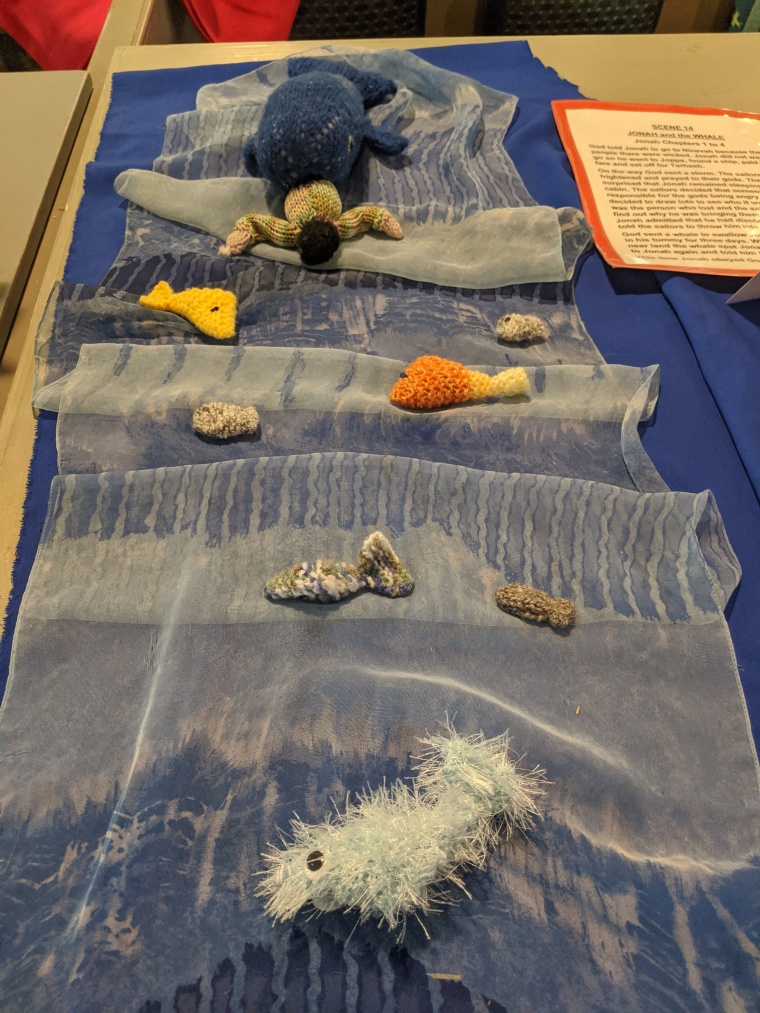
LIFE OF JESUS:

















Just in time for Advent, I’ve bought a bunch of new Christmas books for the resource centre. They should be here within the week, so pop in and check them out if you’re around!
For those churches in our Diocese who are far from St Albans – if any of these look good, email me, and we can send around an APB to Holywell Lodge staff for anyone who will be in your area in the next few days and can bring you what you’d like to borrow.
 So without further ado, here’s what we now have …
So without further ado, here’s what we now have …
Lois Rock is basically the rock star of under-5s Bible stories and prayers. This collection helps adults and very young children together explore the wonder and mystery of the Christmas season through prayer. Perfect for a toddler group, a creche, a visit to your local nursery, inspiration for your crib service …

Another Lois Rock one – I first discovered this when my nephew was three and I gave it to him as a Christmas present. What makes it special is that it includes not only the Christmas story itself, but a wonderful collection of folklore and legends surrounding Christmas. The stories come from all around the world, making it a subtle way of teaching diversity and inclusion, and Alex Ayliffe’s wonderful illustrations are simple and colourful, but include interesting details for children to spot.

As Elena Pasquali’s simple yet beautiful text tells the Christmas story, Giuliano Ferri’s illustrations tell a second, unspoken one – that of the peaceable kingdom. Bit by bit, the animals gather together around the manger. Lions and lambs lie down together. Bears and donkeys gather in peace. At the end, the text of Isaiah 11 connects this imagery to the prophesy of God’s Kingdom, where “they shall not hurt or destroy in all my holy mountain.”

Another one that combines the Biblical Christmas stories with folklore and legend, this time aimed at older children. Here’s what the publisher says: “This beautifully presented volume of classic Christmas stories from around the world is written for children aged 7+ to enjoy reading alone, or for reading aloud in a classroom setting or with family sitting round a log fire! A mixture of stories from the Christian heritage and more secular tales, these retellings all evoke the true spirit of Christmas around the world. Included are Nativity stories from the Gospels of Luke and Matthew, the stories of Baboushka and Papa Panov, Fir Tree and The Nutcracker. The whole collection sparkles with colourful and detailed artwork from Jane Ray.” (It’s also worth pointing out that Jane Ray’s Mary and Joseph look genuinely Middle Eastern.)

I’ve been an adult for a while now, but this book still sends a shiver of wonder up my spine whenever I read it. It’s based around the Mexican community in the American Southwest, and the tradition of Las Posadas – when Mary and Joseph go around the town looking for a safe place to stay. Here’s the publisher’s summary: “This year Sister Angie, who is always in charge of the clebration, has to stay home with the flu, and Lupe and Roberto, who are to play Mary and Joseph, get caught in a snowstorm. But a man and a woman no one knows arrive in time to take their place in the procession and then mysteriously disappear at the end before they can be thanked. That night we witness a Christian miracle, for when Sister Angie goes to the cathedral and kneels before the statue of Mary and Joseph, wet footprints from the snow lead up to the statue.”
I’d love to hear your recommendations for the Advent and Christmas books we should add to our library – do leave any thoughts in the comments! And let me know if you’d like to borrow any of these.
There are so many ways NOT to do a stained glass window craft, and I’ve probably tried them all.
Black paper and tissue can work, but it means designs end up being abstract, with no opportunity for children to play with symbols and images.
Trying to draw and cut silhouettes requires a lot of practice – children don’t easily grasp the concept that the details you draw on your silhouette won’t show up in the window.
However, after much trial and error, I’ve now finally found a way to create the translucent effect in a user-friendly format.
You will need:
If you don’t have a laminator, you can make frames for the windows out of stiff card – but this is probably more labour-intensive.
Simply cut the wax paper to the size and shape required, and let the children loose with the Sharpies. When they’re done, allow the work to dry fully before laminating.
Notes:

Here are the slides for the Bible Basics session at Great Barford Lower School on 4th September:
And here are the “lesson ideas” from the longer full-day presentation, in case anyone wants them:
The Busted Halo videos are all here.
And click here for the link to the free “Books of the Bible” poster.
If you would like the script for “The Big Story,” please email cme@stalbans.anglican.org .
Jane Hatton, one of the chaplains at the Lister Hospital, has lived in Knebworth for over thirty years. Serving on the board of governors of the local school – which isn’t a CoE school – and getting to know the staff, she earned the trust of the school leadership over time, and eventually felt she was able to suggest having a prayer space in the school.
In discussions with the school, it was decided that the space would be called “Soul Space,” as some people felt the word “prayer” carried specific associations. The space was designed to include information about what Christians believe about God, but not to proscribe these beliefs, and to allow children to participate fully without having to share a Christian view of God or the world.
For a short video about last year’s Soul Space, click here.
Jane told me she doesn’t feel like a natural with children’s work, so she surrounded herself with volunteers who felt more at home with kids – they came from St Martins church, Trinity Church (both in Knebworth) and from Bridge Builders, as well as chaplaincy volunteers and retired clergy.
Through a few planning meetings (one of which I was lucky enough to attend), a few themes were decided on, and activities from Prayer Spaces in Schools were chosen. “We wanted a mix of activities looking inward (to ourselves), looking outward (to others), and looking upward (to God),” Jane said. The volunteers attended the planning meetings and contributed lots of ideas.
One of the “looking upward” activities invited children to imagine they were in charge of the world. What would they change? What would stay the same? What questions do you have for God? Write them as a tweet.

They were then invited to think about transformation, and change, and how the world should be transformed. A butterfly image was used to represent this. Click here for the resources for this activity.
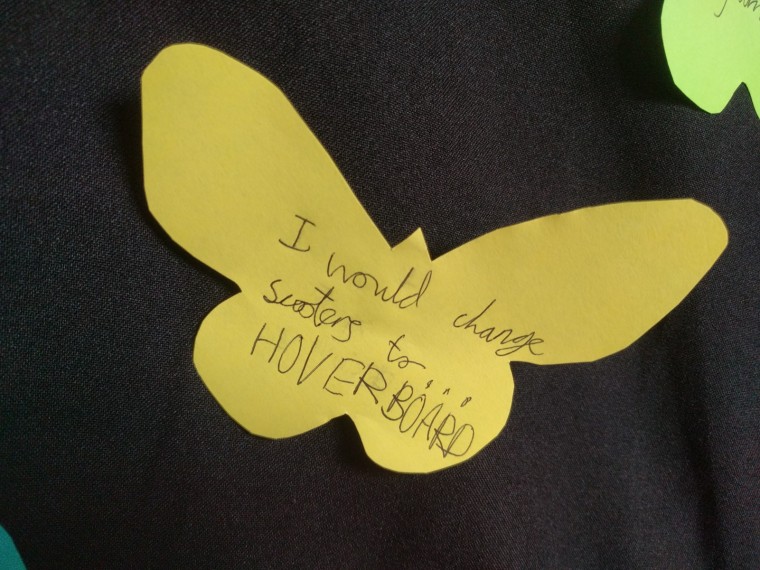 The prayer space was scheduled to be open for two days in late July, so some activities focused on looking ahead to the next school year, and, for the Year 6 pupils, the transition to secondary school.
The prayer space was scheduled to be open for two days in late July, so some activities focused on looking ahead to the next school year, and, for the Year 6 pupils, the transition to secondary school.

The Calm Zone included space to write hopes and fears about the future, as well as Calm Jars (click here for more) and Bubble Tubes (click here) to help pupils relax.

Pipe cleaner people, next to photos of every class in the school, were used to help children reflect on the school year that is ending, and pray for those who have helped them. For more on Pipe Cleaner People, click here.
Volunteers chose a particular corner that was “theirs” – they introduced children to the activity there, and were on hand to support and talk if needed. Two volunteers were “spare” – i.e., not assigned to a particular corner. Their job was to manage the timings and to jump in and help if needed.
For the running of the space itself, the plan was:
Soul Space is now in its second year, and I had the chance to visit it last week.



The powerful Refugee Rucksacks activity is an age-appropriate way to help children learn about and pray for refugees. It invited children to think about what they would bring if they had to leave their home because of war. It works well with this photo essay of refugees sharing what they brought with them, what they’ve lost along the way, and what they are hoping for in their new lives.
The final activity was Finger Print. It explained that Christians believe in a God who made each of us and loves each of us, and invited children to add their unique fingerprint to a large fabric print on the wall. There were also two prayer boxes available at this station.
The children’s feedback sheets were done in a way that new/non-readers could participate in, with a bit of adult help. The list of stations can help you find those activities on the Prayer Spaces for Schools website (you have to register to download the resources, but registration is free).

Lessons:
I had the chance to visit St. Mary’s in Baldock recently, and to my surprise I found I was sharing my pew with … a pig!
No, I’m not insulting the person sitting beside me – there was an actual pig there. All right, so it was knitted, but it was still very much of a porcine persuasion.
It turns out that these pigs, which were knitted by a member of the congregation, serve as tour guides to children who visit the church! They’re for children who come to worship, children who come on school visits – any child who wants to figure out what the bits of the church building are for can be shown around by the pigs.
There’s a little leaflet, and each pig has a sign around its neck telling the child what its job is.
(I’m willing to bet the pigs have educated many adults as well.)
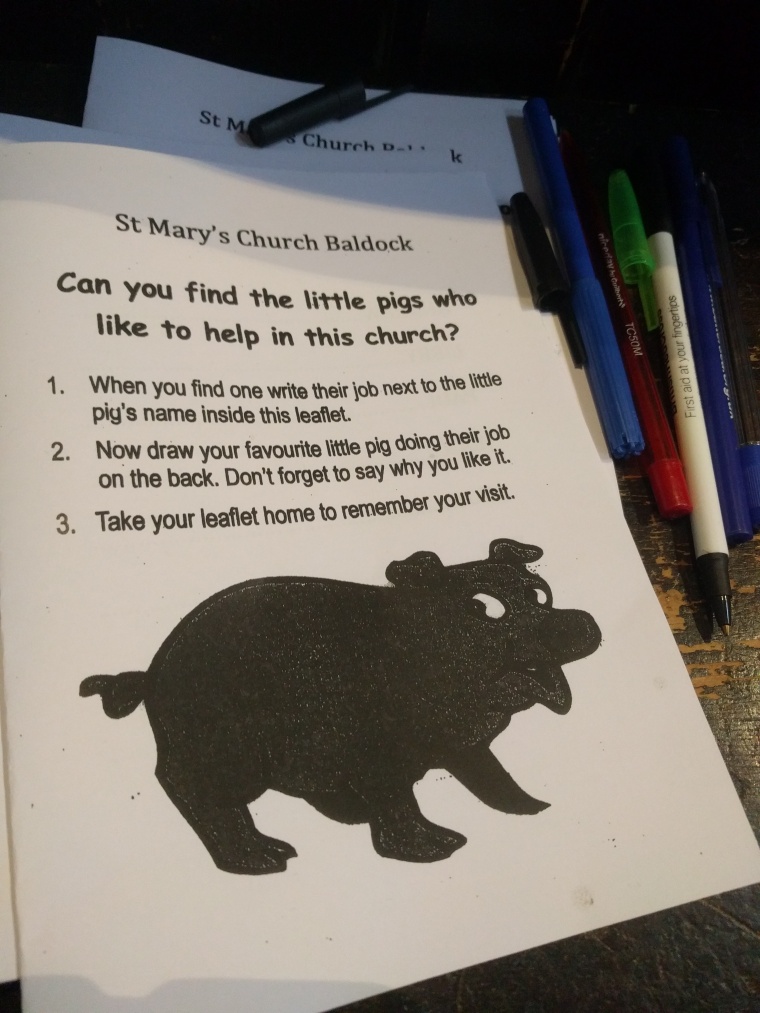
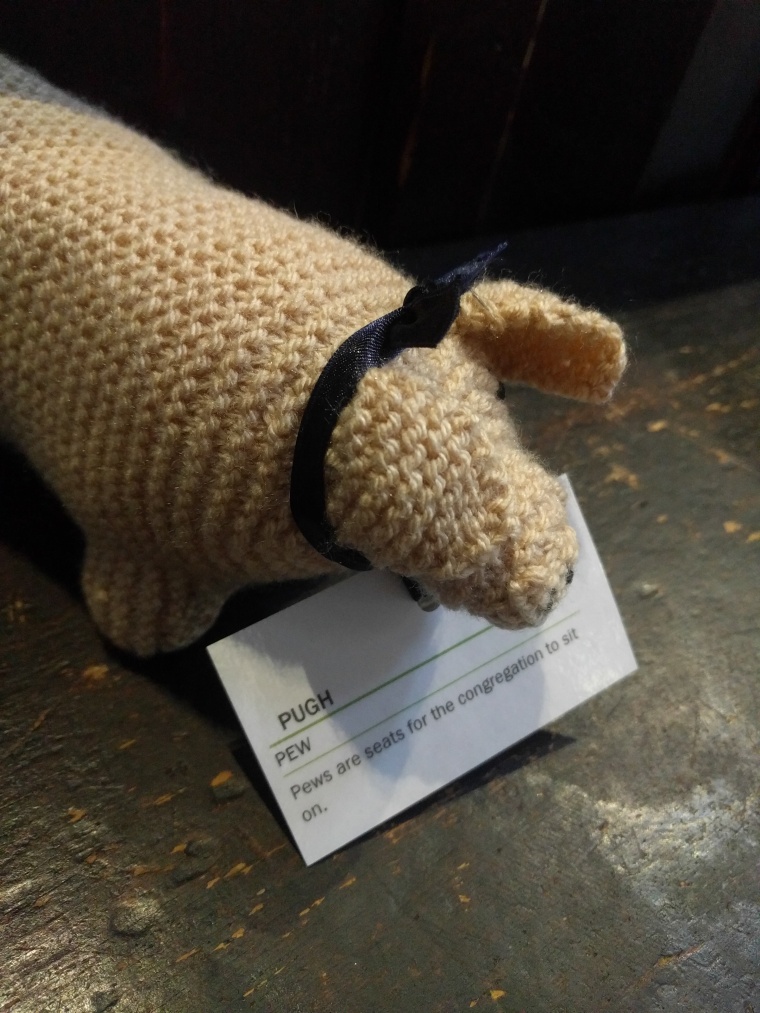
I often find myself reminding people that you don’t have to be “good with kids” to help with children’s ministry. The pigs have a huge impact on the church’s welcome, and also affects their schools ministry. But you don’t have to feel confident leading a children’s group in order to get involved. You can be a knitter, you can write the labels and print and laminate them, you can make sure the leaflets are restocked and there are pens available … these sorts of things are ways to get more of your congregation supporting your children’s work, even if they’re not comfortable doing hands-on work with the kids themselves.